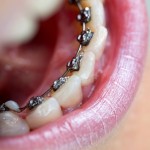
Traditional fixed orthodontic appliances impact on patients’ aesthetic appearance. The use of lingual orthodontic appliances has been developed as one approach to address these problems. The aim of this review was to assess the effectiveness of lingual orthodontic treatment and related clinical parameters.
Methods
Searches were conducted in the Medline, Embase, Google scholar beta, all Cochrane Databases, and Conference Paper Index databases. Randomised clinical trials (RCTs), prospective controlled clinical trials (CCTs), or retrospective studies with a control group reporting on results or treatment parameters related to orthodontic treatment performed with fixed lingual brackets bonded at least to all teeth between first molars, in one or both arches and published in English, German, French or Italian were considered. Two reviewers independently selected studies, abstracted data and assessed study quality. The Cochrane risk of bias tool and the Newcastle–Ottawa scale were used to assess study quality. Meta-analysis was not conducted.
Results
- 16 studies (11 retrospective, 4 CCTs, 1 RCT) were included.
- 6 studies evaluated differences of the treatment outcome from the pre-treatment set-up prediction.
- 2 studies evaluated the effect of treatment on periodontal and microbial parameters.
- 10 studies assessed various clinical treatment related parameters.
Conclusions
The authors concluded:
This systematic review showed encouraging results on the clinical outcome of lingual orthodontic treatment, especially in regards to the achievement of individualized treatment goals and the decreased risk of decalcifications on the bonded surfaces of the teeth. However, additional well-designed prospective clinical trials with large samples are needed to confirm those findings. Several aspects of lingual orthodontic treatment were difficult to be conclusively evaluated due to the study design, the heterogeneity, the small samples, and the high risk of bias seen in the majority of the included studies.
Comments
The authors have conducted a wide search for studies and included a number of languages. They decided only to include studies published after 2000 as they considered that developments in appliances and techniques since then would be more representative of current clinical practice. However, the majority of included studies were retrospective in nature with only 5 trials being included and only one of these being randomised. So while the available evidence does suggest encouraging clinical outcomes from the available data there is no high quality evidence available to assess the effectiveness of lingual orthodontics so large high quality trials are needed.
Links
Mistakidis I, Katib H, Vasilakos G, Kloukos D, Gkantidis N. Clinical outcomes of lingual orthodontic treatment: a systematic review. Eur J Orthod. 2015 Sep 10. pii: cjv061. [Epub ahead of print] Review. PubMed PMID: 26359019.

Lingual orthodontics – well designed trials needed http://t.co/7BhoN4AnSj
No high quality evidence available to assess the effectiveness of lingual orthodontics
http://t.co/7BhoN4AnSj
Little high quality evidence for lingual orthodontics http://t.co/7BhoN4AnSj
Don’t miss – Lingual orthodontics –no high quality evidence of effectiveness http://t.co/7BhoN4AnSj
[…] http://www.nationalelfservice.net/dentistry/orthodontics/lingual-orthodontics-no-high-quality-eviden… […]